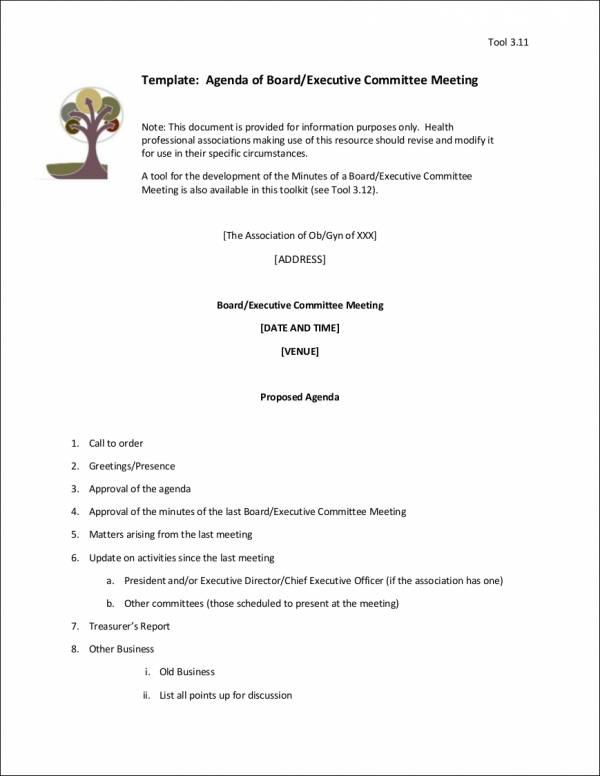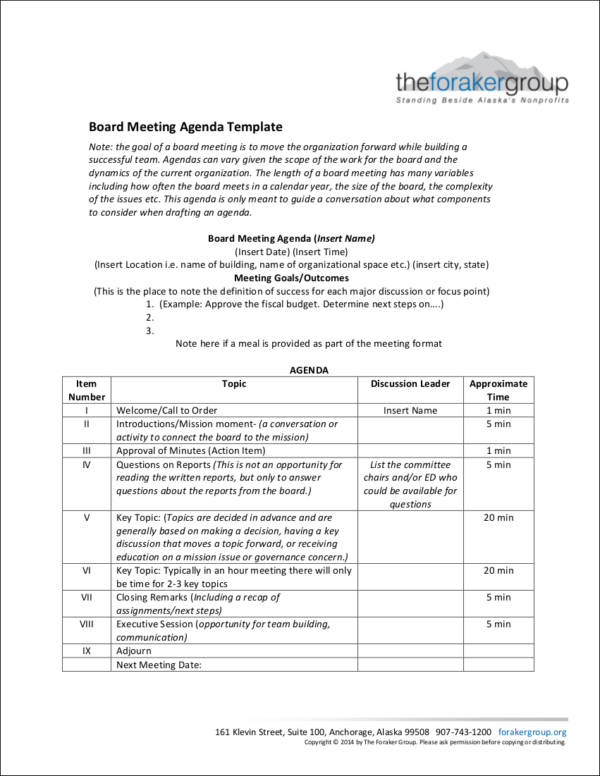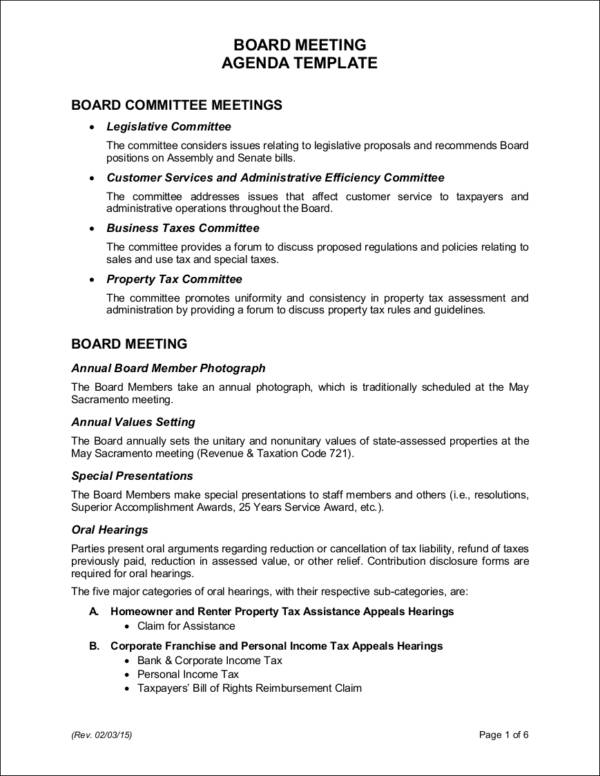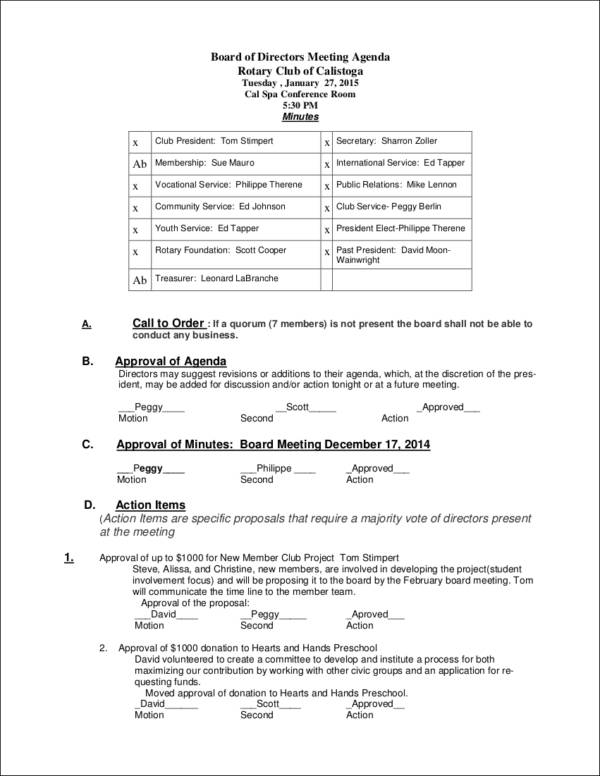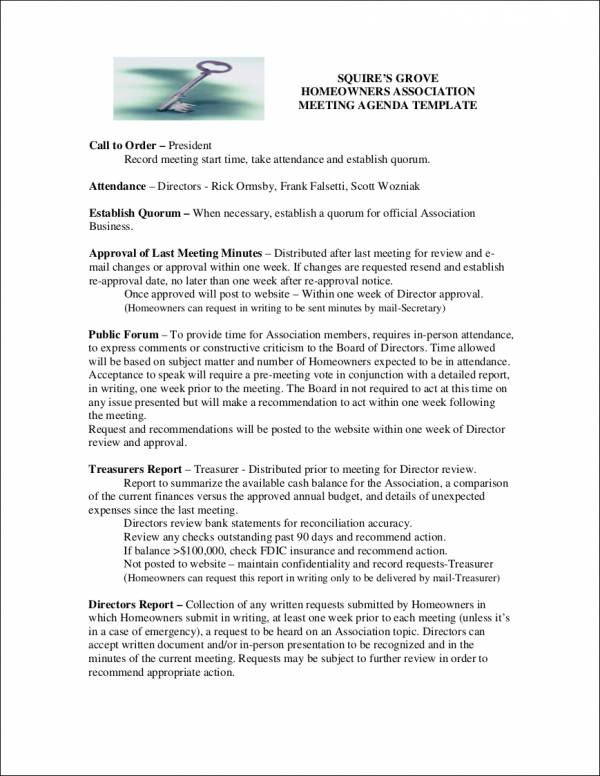Every business owner should understand the value and importance of conducting meetings in the company on a regular basis. These meetings allow businesses to share and create ideas, make important decisions, and discuss issues within the company, which is why ensuring that the meetings done in the business are organized and productive is important. Due to the hectic schedules and various tasks that individuals deal with daily, they often forget about the importance of preparing and planning, especially when conducting business meetings.
This can result in a boring and unproductive meeting. How do you ensure that the meetings done in the business are productive and organized? One of the most important documents that can be prepared is an agenda. There are many types of meetings that a business can have, whether it is a new project that the company is launching, planning new products and services for the business, and so on. One example of this is a board meeting.
As mentioned, preparing an agenda will help the business conduct productive and successful meetings, ensuring that it is properly organized. In this article, we have listed down the definition of a board agenda, the purpose of creating one, the essential components of a board meeting agenda, and some tips that can be useful to guide you when creating one. We also have various board meeting agenda samples and templates that you can download on this page. Should you need other types of samples, you can also browse through our collection of other agenda samples available on our website.
Board Meeting Agenda
Executive Committee Meeting Agenda
Board Meeting Agenda in PDF
What Is a Board Agenda?
A board agenda or a board meeting agenda is a document or tool that is used to list down the schedule or the items that will be covered in a company’s board meeting. When an organization’s board of directors gather for a formal meeting to discuss issues regarding a business’s policies, as well as other major issues, a board meeting agenda is essential. It is used to outline the items or topics, including all the other important information like the location of the meeting, the date and time, the roles of each participant, and the time allotted for each topic or issue. Through a board agenda, the board of directors or the individuals present during the meeting will be able to prepare all the necessary materials and items needed during the meeting.
Purpose of a Board Meeting Agenda
Meetings conducted without a proper agenda can mean chaos not only for the participants of the meeting but can also affect the overall operations of the business. One of the main problems of conducting a meeting without a properly prepared agenda is the failure to accomplish the smart goals and objectives of the meeting. In order for you to further understand the purpose of a board meeting agenda, we have listed below its purposes and how it can result in actionable productivity.
The purpose of a board meeting agenda is as follows:
- The main purpose of a board meeting agenda is not only to help you prepare for the meeting but also in planning the issues and topics that are to be discussed in the meeting. By preparing an agenda a few days before the actual meeting, you will be able to gather updates on agenda items as well as collect inputs from the different board members of the business. This will also allow participants to create the important general reports and other documents needed during the meeting.
- A meeting agenda will allow the facilitator of the meeting to control the flow of the discussions. Since an agenda contains a set time frame for each topic to be discussed, this will prevent you from discussing topics that are irrelevant to the purpose of the meeting, which will not only help you focus on the issues at hand but also helps you save time.
- Through a board meeting agenda, meetings will become more productive, especially since participants already know what to expect during the meeting. They will also have a clear understanding of what items are needed to be accomplished after a meeting has ended since meetings often include action items.
- A meeting agenda format also allows businesses to document every meeting that they will be having. It provides a comprehensive documentation regarding what has taken place during that particular meeting, the decisions that were made, and the action items that have been completed or developed.
Printable Board Agenda
Board Committee Agenda
Board Association Agenda
Essential Components of a Meeting Agenda
An effective board meeting agenda should include all the essential components necessary in an agenda. Ensuring that these items are present in the document will allow you to properly provide the right information to the participants of the meeting. Below, we have listed the essential components of a board meeting agenda.
The components are as follows:
Type of Meeting
Your document should specify the type of agenda that you will be creating. Since there are many types of meetings in a business, it is important to indicate the type of meeting or the topic of the meeting that will be conducted. This will give participants an overview of what the meeting is about.
Date of Meeting
Specifying the date of the meeting is essential to ensure that everyone who will be invited to the meeting can clear up their schedules ahead of time.
Start and End Time
In this section, specify the exact time when the meeting will start, as well as when it will end. By doing this, you can assure that the participants of the meeting will arrive early.
Location of the Meeting
Stating the exact location where the meeting will happen is important so that attendees will know where to go. You can include the address of the location, especially if you will be having a meeting off-site or in another location other than the company’s premises.
Roles of Attendees
This section is an important component in any agenda. It is important for you to list down the roles that each particular attendee or participant will play in the meeting. Any meeting roles such as the meeting facilitator, minute taker, timekeeper, contributor, guest, etc., should be clearly specified in the document.
Topics and Subtopics for Discussion
Provide an overview of the topics as well as topics for discussion. Listing down the topics will help you keep track of the progress of the meeting. Also, remember to include a time frame for each topic that will be covered. By allotting the time required for each topic, you can assure that discussions will remain relevant to the purpose of the meeting.
Board of Directors Meeting Agenda
Board of Education Agenda
Homeowners Association Board Agenda
Club Board Meeting Agenda
Pointers to Consider When Creating a Board Agenda
When you create a board meeting agenda, there are a few guidelines or pointers that you need to consider to be able to create an effective board agenda for your meeting. Here are some of the pointers that you need to remember when creating a board meeting agenda.
- Always remember to keep your board meeting agenda clear and simple. Since an agenda is a document that is created for the purpose of a business meeting, keeping the layout and the design of your document as simple as possible is essential. All the information written in the document should be laid out properly in order for the meeting attendees to easily navigate through the agenda.
- Keep your board meeting agenda concise and on point. Your agenda doesn’t need to contain a detailed information about the topics that will be discussed during the meeting, especially since an agenda is only an overview or a summary of the meeting and a guide for the attendees.
- Remember to use simple fonts. Although you may be tempted to add certain designs to your agenda, specifically the font style, using simple fonts will make it easier for the attendees of the meeting to read and follow the agenda. Since an agenda is a formal business letter document, using fonts like Arial, Times New Roman, Helvetica, etc., is more appropriate. Also, keep the font size between 11 to 12. This will make your agenda look professional.
- Clearly allocate a time for each of the agenda items or topics that will be discussed in the meeting. This is to ensure that all the items that will be discussed are covered within the time allotted for the meeting. This will guide the presenter on how long he/she will talk about these agenda items.
- Always get input from the individuals involved in the meeting. Your team members’ inputs are essential when creating a board meeting agenda to be able to cover all the points, issues, and suggestions to be discussed.
- Prepare and send out a board meeting agenda beforehand. This is done to allow board members and other participants of the meeting to prepare the materials, slideshows, and other things that are relevant to the meeting.
Now that you have read about all the important information regarding a board meeting agenda, ensure that you follow them when creating your own agenda in order to have a productive, as well as an organized meeting every time. If you need other types of agendas such as a training agenda, workshop agenda, political agenda, etc., you can download them on our website.
Related Posts
FREE 10+ Client Meeting Agenda Samples in MS Word | Pages | Google Docs | PDF
FREE 10+ Strategy Meeting Agenda Samples in PDF
FREE 10+ Family Meeting Agenda Samples in PDF
FREE 10+ Day Agenda Samples in MS Word | Pages | Google Docs | PDF
FREE 10+ Program Agenda Samples in PDF
FREE 10+ Committee Meeting Agenda Samples in MS Word | Pages | Google Docs | PDF
FREE 6+ Wedding Agenda Samples in MS Word | PDF
FREE 10+ Retreat Agenda Templates in PDF | MS Word
FREE 10+ Interview Agenda Samples and Templates in PDF | MS Word
FREE 7+ Travel Agenda Samples and Templates in PDF
FREE 10+ Project Agenda Samples and Templates in PDF | MS Word
FREE 12+ Sales Agenda Templates in PDF | MS Word
FREE How Meeting Agendas Result in Actionable Productivity [ Making Your Meeting Agenda ]
FREE First Advisory Board Meeting Agenda [ Importance and Tips ]
FREE Strategies to Overcome the Risk to Your Company’s Agenda [ Definition, Steps for Overcoming Risks ]


